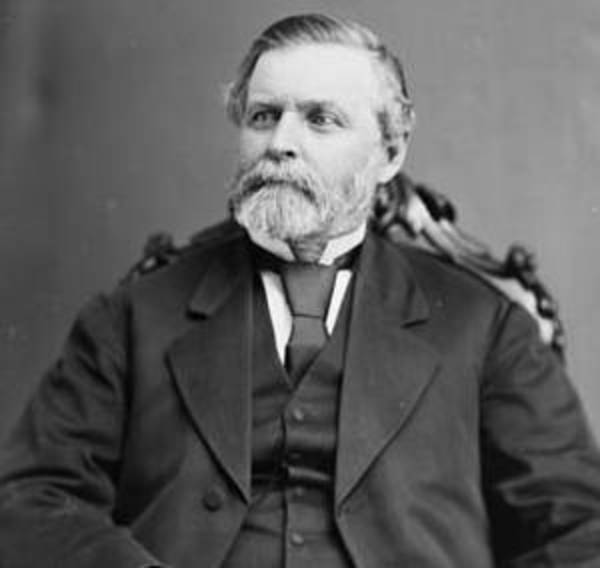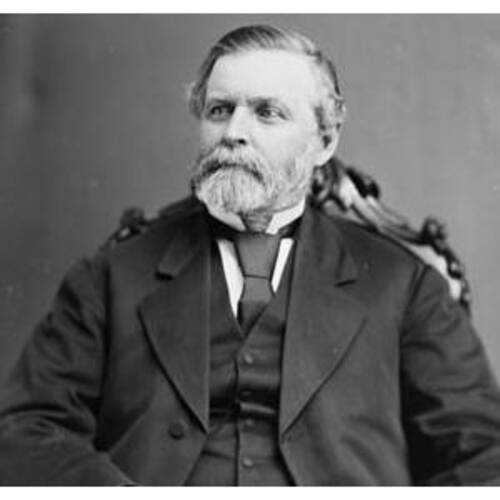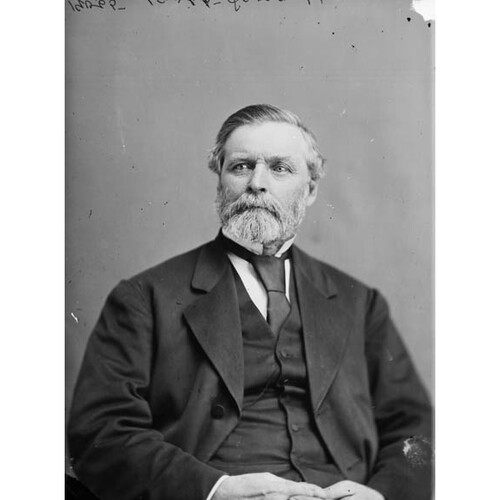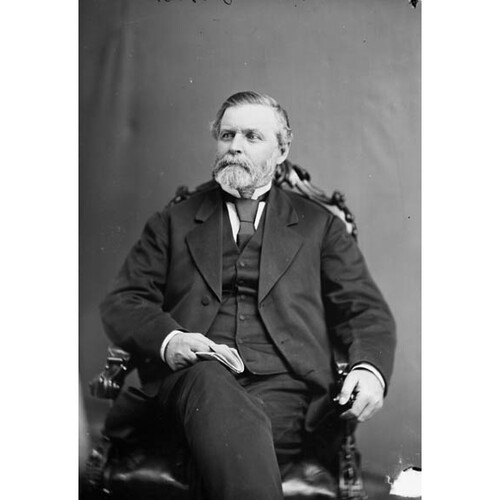
Source: Courtesy of Wikimedia Commons
LEONARD, ELIJAH, iron-founder, businessman, and politician; b. 10 Sept. 1814 near Syracuse, N.Y., second child of Elijah Leonard* and Mary (Polly) Stone; m. 15 June 1847 Emeline Woodman, daughter of Elijah Crocker Woodman*, and they had three sons and three daughters; d. 14 May 1891 in London, Ont.
Soon after Elijah Leonard’s birth on a farm near Syracuse, his father acquired an iron-furnace at Taberg, N.Y., and moved the family to that location. Some time afterwards Elijah Sr purchased a furnace at Constantia, but by about 1824 he and his family had returned to farming near Syracuse. In 1830 the family joined him at Normandale, Upper Canada, where he was employed at the ironworks and foundry of Joseph Van Norman*. Here Elijah Jr learned the trade of moulding.
Although the works prospered, the Leonards realized that chances for advancement were limited, and they sought a location for a foundry of their own. After investigating Hamilton in 1834, Elijah Jr decided that St Thomas seemed promising. In May he and his father, in partnership with Philip Cady Van Brocklin, established a foundry there. The partnership was dissolved in September, by which time the Leonards had purchased Van Brocklin’s share and Leonard Sr had retired from active participation. His son then managed the operation under the name E. Leonard Jr and Company.
The financial crisis of 1837 [see Sir Francis Bond Head*] proved to be a strain on the business. That year Leonard, who as an American would be accused of spying during the rebellion, went to Monroe and Ann Arbor, Mich., to explore relocation, but was no more satisfied with their potential than that of St Thomas. London, however, though no larger than St Thomas, had the attraction of being a garrison town, with its attendant business. Consequently, in 1840 Leonard set up a machine-shop and foundry in London at Fullarton and Ridout streets. He did not totally abandon his St Thomas base, however, and the foundry there was run by two of his brothers, Lyman and Delos, until 1842. Leonard then operated it in partnership with John Sells, who purchased his share of the business in April 1851. About 1842 Leonard had assembled his first steam-engine from parts purchased in Cleveland.
In London Leonard developed a large market for agricultural machinery, producing his first threshing machine about 1846. In 1848 he manufactured his first boiler. But it was the railway boom of the early 1850s that seemed to offer his first opportunity for prosperity. The foundry constructed dump cars, road scrapers, and track material for the Great Western Railway. Then, in 1853, through his father’s contacts, Leonard acquired a contract to build 200 boxcars for the company. This undertaking exceeded the capacity of his plant and consequently a second foundry was erected, at York and Waterloo streets. Since the casting of railway wheels proved too difficult, however, Leonard supplied the cars without axles and wheels, delivering them between February 1855 and September 1856. Early that year Leonard had acquired the contract to supply all cars and a turntable for the London and Port Stanley Railway. His firm’s increasing technical skill enabled it to supply these cars with wheels.
The railway contracts proved so time-consuming that regular local business was lost. The Great Western was slow to pay, causing Leonard some commercial embarrassment. He suffered further personal loss when he was held responsible for his portion of the bond of his brother-in-law, Henry Black, who had absconded as Elgin County treasurer. When railway construction ceased during the crisis of 1857, Leonard had little work to fall back on. It took several years to re-establish his agricultural business. Even then there were set-backs; his design for a reaper did not work and he abandoned the project. Prosperity did not return until the American Civil War. Over the next few years the business was consolidated in the York Street foundry.
Leonard’s operation underwent fundamental changes in business strategy during the 1870s. By 1875 expansion of trade allowed him to admit his two surviving sons, Frank Elton and Charles Weston, into partnership, forming E. Leonard and Sons. That same year he secured his first major contract, with the Sarnia waterworks, in the line of boilers and engines. In 1879 he produced his first steam farm-tractor, but stationary boilers and engines became the mainstay of the foundry. With this specialization the company’s market expanded out of southwestern Ontario. In 1882 an agency was established in Montreal, followed five years later by one in Saint John. The success of the firm in that region is reflected in the claim of the Saint John Sun in 1909 that “there are few names better known than E. Leonard & Sons in the Maritimes today.”
While Leonard ultimately prospered by specializing in steam equipment, he had steadily pursued a variety of business interests. In the early 1850s, in addition to building cars, he and a partner contracted to build an engine-house for the Great Western. In 1852 he joined in another partnership to sell 200 acres of land in London. As a sign of his growing prosperity, he built an imposing Regency-style house in 1854 on lots retained from this real estate company. From 1869 to about 1879 he operated a grist-mill in his newly expanded foundry, and for a few years made staves there. In addition to businesses in which he was an active participant, Leonard was a shareholder in the London and Port Stanley Railway Company, formed in 1853, and was an incorporator in 1857 of the London and Lake Huron Railway Company. At an early date Leonard and others organized the London Savings Bank. Later, he was one of the original promoters of the Huron and Erie Savings and Loan Society, organized in 1864; he acted as a director until 1890.
Leonard served with a number of public organizations in London. He was the first president of the mechanics’ institute, established in 1841, and in the early 1850s he helped organize the town’s volunteer fire brigade, on which he served for three years. In 1852 he was a founding member of the Horticultural and Mechanical Association and that year was elected to the first committee for the county agricultural society, the precursor of the Western Fair Association, which organized one of southern Ontario’s major agricultural fairs. Elected a municipal councillor in 1854, the year London was incorporated as a city, he became its third mayor in 1857. A Reformer, he ran that year for the Legislative Assembly against John Carling* but was defeated. In 1862 he was elected to the Legislative Council for the Malahide division. Five years later, at confederation, he was appointed a senator, a position he held until his death in 1891. According to a biographical account in 1889, Leonard took “little part in party politics, but his sympathies are with the Reform party, of which he is an influential member in the Senate.”
Following his death, his firm was continued by his two sons and its presidency remained in the family until 1945. During that period the company experienced further specialization, dropping steam-engines early in the century and concentrating on electric boilers and other pressure vessels.
A volume of Elijah Leonard’s reminiscences was edited by his son Frank Elton Leonard and published as The honorable Elijah Leonard: a memoir (London, Ont., [1894]).
Baker Library, R. G. Dun & Co. credit ledger, Canada, 19: 43 (mfm. at NA). London Public Library and Art Museum, London Room, E. Leonard and Sons, scrapbooks. NA, RG 1, L3, 298: L3/L49. UWOL, Regional Coll., Leonard family papers, esp. vols.1840, 1891; [R.] A. Trumper, “The business policy evolution of E. Leonard and Sons” ([1935?]). Canada Inquirer (London), 24 Sept. 1841. Canadian biog. dict. Hist. of Middlesex. London heritage, ed. T. W. Honey (London, 1972). R. A. Trumper, “The history of E. Leonard & Sons, boiler-makers and iron-founders, London, Ont.” (Dept. of Business Administration thesis, Univ. of Western Ont., London, 1937). Sun (Saint John, N.B.), 23 Sept. 1909.
Cite This Article
Christopher Andreae, “LEONARD, ELIJAH (1814-91),” in Dictionary of Canadian Biography, vol. 12, University of Toronto/Université Laval, 2003–, accessed April 2, 2025, https://www.biographi.ca/en/bio/leonard_elijah_1841_91_12E.html.
The citation above shows the format for footnotes and endnotes according to the Chicago manual of style (16th edition). Information to be used in other citation formats:
| Permalink: | https://www.biographi.ca/en/bio/leonard_elijah_1841_91_12E.html |
| Author of Article: | Christopher Andreae |
| Title of Article: | LEONARD, ELIJAH (1814-91) |
| Publication Name: | Dictionary of Canadian Biography, vol. 12 |
| Publisher: | University of Toronto/Université Laval |
| Year of revision: | 1990 |
| Access Date: | April 2, 2025 |





